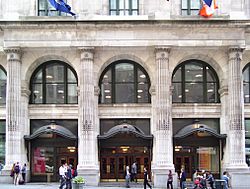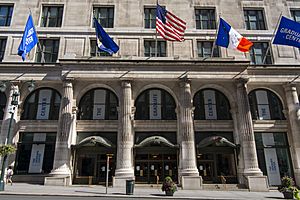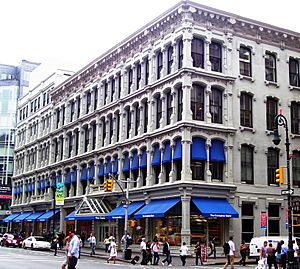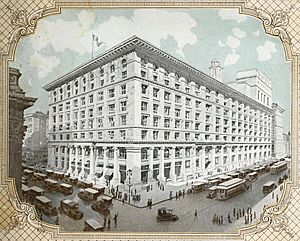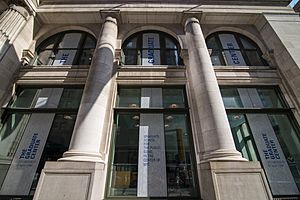B. Altman and Company Building facts for kids
Quick facts for kids B. Altman & Company Building |
|
|---|---|
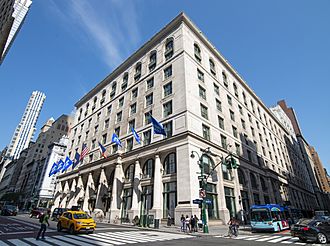
Seen in 2020 from the corner of Fifth Avenue and 34th Street
|
|
| General information | |
| Type | Commercial offices, educational |
| Architectural style | Italian Renaissance Revival |
| Location | 355–371 Fifth Avenue, New York City, US |
| Coordinates | 40°44′55″N 73°59′01″W / 40.74861°N 73.98361°W |
| Current tenants | City University of New York, Oxford University Press |
| Construction started | 1905 |
| Completed | 1914 |
| Opened | 1906 |
| Renovated | 1996 |
| Technical details | |
| Floor count | 13 |
| Design and construction | |
| Architect | Trowbridge & Livingston |
| Main contractor | Marc Eidlitz & Son |
| Renovating team | |
| Renovating firm | Hardy Holzman Pfeiffer, Gwathmey Siegel & Associates |
| References | |
| Designated: | March 12, 1985 |
| Reference #: | 1274 |
The B. Altman and Company Building is a large building in Midtown Manhattan, New York City. It used to be the main store for B. Altman and Company, a famous department store. The building takes up a whole city block between Fifth Avenue, Madison Avenue, 34th Street, and 35th Street. It is directly across from the Empire State Building.
The building was designed by Trowbridge & Livingston in the Italian Renaissance Revival style. Most of it is eight stories tall, but the Madison Avenue side goes up to thirteen stories. Its outside is mostly made of French limestone. The building has a large archway design with columns at its two-story base.
B. Altman's was the first major department store to move from the old "Ladies' Mile" shopping area to Fifth Avenue. Back then, Fifth Avenue was mostly residential. The building opened in different parts between 1906 and 1914. This was because it was hard to buy all the land needed. The store closed in 1989. It was empty until 1996 when it was updated. Today, the building is home to the City University of New York's Graduate Center and the Oxford University Press. The B. Altman and Company Building was named a New York City landmark in 1985.
Contents
Where is the building located?
The B. Altman and Company Building covers a full city block in Midtown Manhattan. It is bordered by Fifth Avenue on the west, 34th Street on the south, Madison Avenue on the east, and 35th Street on the north. The land area is about 82,950 square feet. It measures 197.5 feet from north to south and 420 feet from west to east. The ground is slightly higher on the northern ends of the Fifth and Madison Avenue sides.
The B. Altman Building is near several other important places. These include the Empire State Building to the southwest and the Church of the Incarnation to the northeast. It is also close to the Collectors Club of New York and the Madison Belmont Building. This area of Fifth Avenue has many other former large retail buildings.
How was the building designed?
The B. Altman and Company Building was designed by Trowbridge & Livingston. It features the Italian Renaissance Revival style. The building opened in three stages: 1906, 1911, and 1914. The main part on Fifth Avenue, which opened in 1906 and grew in 1911, has an arched design. The Madison Avenue part, finished in 1914, has more decorative details than the original Fifth Avenue section.
Most of the building is eight stories tall. However, the Madison Avenue side reaches 13 stories. The first part of the building had entrances on Fifth Avenue, 34th Street, and 35th Street. The newer section added two more entrances on Madison Avenue and 35th Street.
What does the outside look like?
The building's outside was made to fit in with the grand mansions on Fifth Avenue. At the time, this area was mostly residential. The design was meant to match the fancy homes nearby. The New York Times called the design "classic." It used French limestone imported from other countries. The B. Altman Building was the first commercial building in New York City to use this material. Before this, it was only used for homes.
All four sides of the building look similar. On every side, the first two floors have an archway design. The third through sixth floors have square windows. The seventh and eighth floors also have an arched design. The Fifth and Madison Avenue sides each have nine sections of windows. The Fifth Avenue side is eight stories tall, while the Madison Avenue side is 13 stories. The 34th and 35th Street sides are 17 sections wide and mostly eight stories tall. However, the easternmost four sections go up to the thirteenth story. The outside of the building is mostly the same as when it was finished.
The lower floors
On Fifth Avenue, the first two stories have a row of columns. These columns are tall and support a flat beam above them. The middle four columns are grooved, marking a slightly sticking out entrance. Inside each section of columns, the first and second-floor windows are separated by stone beams. The first-floor windows are large display windows. The second-floor windows are half-circle shaped. At the main entrance, small stone steps lead to the doors, which are under glass canopies. This entrance leads to the CUNY Graduate Center.
On 34th Street, the first two stories mostly have flat, rectangular columns instead of round ones. There is an entrance in the sixth, seventh, and eighth sections from the west. It has grooved columns like those on Fifth Avenue. Only the seventh section has a glass canopy and stone steps. On the first floor, only some windows are display windows. Others are wide rectangular windows behind a metal screen. A service entrance is also on this side. The second-floor windows are half-circle shaped.
The Madison Avenue side has a row of columns in the middle seven sections. The sections on the very ends stick out slightly and have rectangular columns. The middle section used to be the library entrance.
The 35th Street side is similar to the 34th Street side but less fancy. Some sections have display windows, while most others have rectangular windows behind a screen. One section has a metal entrance that sticks out a bit. There is also a delivery entrance closer to Madison Avenue.
The upper floors
The third through eighth stories look the same on Fifth Avenue, 34th Street, and 35th Street. The third story has square windows with decorative stones above them. A horizontal band runs above these windows. The fourth through sixth stories have simple square windows. A decorative band runs above the sixth floor. The seventh and eighth stories are designed like a tall archway, similar to the base. Each section has a square window under a half-circle window. A heavy ledge runs above the eighth story on Fifth Avenue and most of the 34th and 35th Street sides.
The four eastern sections on 34th and 35th Streets are thirteen stories tall. The top five stories are made of brick, not limestone. The ninth story has two double-hung windows in each section. The tenth and eleventh stories have windows set back inside a large opening. These windows are separated by small iron columns. The top two stories have double-hung windows like the ninth story. A decorative band supported by brackets runs above the twelfth story, and a small ledge is above the thirteenth story.
On Madison Avenue, the outer sections are covered in limestone up to the eighth story. The inner sections and the ninth through thirteenth stories are made of brick. The outer sections look similar to the easternmost sections on 34th Street. The inner sections have pairs of double-hung windows on the third floor. The fourth through sixth stories have very tall window openings. Each of these tall openings has a pair of columns. The seventh and eighth floors of the inner sections are designed as an archway, similar to the other sides, but with iron columns. The ninth through thirteenth floors are the same as on the other sides.
What was inside the B. Altman store?
When the B. Altman store was finished, it had 39 elevators. There were 22 for customers, 10 for employees, two large truck elevators, and five smaller private elevators. The building also had its own electric power plant, which was said to be the city's largest. The air system could move 20,000 cubic feet of air per minute. To send packages and messages, the building used a big system of brass tubes and canvas belts.
On the ground floor, there was a large round entrance hall on Fifth Avenue. The selling floors were open and spacious. The round hall had a glass dome with soft lighting. In the 1930s, this hall was replaced with escalators. The inside of the store had very high ceilings. The first floor was 22 feet high, and the second and third floors were 18 feet high.
When the store opened in 1906, the first through fourth floors were for selling goods. The upper floors were used for workshops, offices, and storage. On the third floor, where suits and linens were sold, there was a large room with mirrors. The fourth floor had a waiting room with wooden desks, chairs, and telephones. When the Madison Avenue part opened, public areas expanded to the fifth floor. This floor had a women's writing room, an information desk, telephones, and a general store. The eighth floor had a restaurant called Charleston Gardens. The ninth floor had special vaults for storing furs, protected by thick cork. Employee areas, like restrooms, dining rooms, and medical rooms, were on the twelfth floor.
What is the building used for today?
Since it was updated in the 1990s, the B. Altman Building has been shared by the City University of New York (CUNY)'s Graduate Center and Oxford University Press (OUP). A third occupant, the New York Public Library (NYPL), sold off its space to other owners in the 2010s.
The CUNY Graduate Center is on the Fifth Avenue side. The first through seventh floors have classrooms, student areas, and offices. The Graduate Center's library is on parts of the first floor, basement, and second floor. This part of the building also has three performance spaces. These include the Harold M. Proshansky Auditorium, the Baisley Powell Elebash Recital Hall, and the Martin E. Segal Theatre. The ground floor also has the Amie and Tony James Gallery. An eighth-floor dining room has 40-foot ceilings and a skylight where you can see the Empire State Building.
On the Madison Avenue side, the NYPL used to have an eight-floor section from the 1990s. This NYPL space was divided into four parts in 2012. Before 2020, the NYPL's Science, Industry and Business Library (SIBL) used five floors in the building. It had a research library in the basement, a lobby and lending library on the ground floor, and offices on three upper levels. This library branch had various business and training centers, meeting rooms, and book storage areas. Oxford University Press (OUP) uses a five-floor section of the building.
History of the B. Altman Building
B. Altman and Company started with a store in the Lower East Side run by the Altman family. By 1865, the store was owned by Benjamin Altman and was at Third Avenue and 10th Street. As New York City grew, people and businesses moved uptown. By the 1870s, stores like B. Altman and Company opened in the "Ladies' Mile" area, between 14th and 23rd Streets. Altman's opened a store on Sixth Avenue. However, by the late 1800s, the Sixth Avenue location became less desirable. This was partly due to the noise and shadows from the elevated train line.
Benjamin Altman first thought about moving his store to Herald Square, across from Macy's Herald Square. But he chose a spot on Fifth Avenue instead. This was because of the Waldorf–Astoria hotel nearby and because Fifth Avenue did not have an elevated train line. In the early 1900s, many new buildings were being built on Fifth Avenue north of 34th Street. Many stores on that avenue were in old 19th-century homes that had been rebuilt.
Building the new store
Buying the land
Benjamin Altman started buying land for his Fifth Avenue store in 1896. He first bought a four-story building at the corner of Fifth Avenue and 35th Street. Altman did not tell anyone why he was buying these properties at first. He did not buy another property until 1901. Purchases on the block sped up after plans for Pennsylvania Station and Grand Central Terminal were announced in 1902 and 1903. These were two major transport hubs nearby. Altman initially had trouble buying some properties because owners did not want to sell.
Plans for the new Altman's store were officially announced in December 1904. By then, Altman had bought many properties on the block. The announcement caused more real estate deals in the area. Trowbridge & Livingston were chosen as the architects the next month. A representative for B. Altman and Company said the Fifth Avenue part of the building would be built first, then the Madison Avenue part. Plans for the building were filed in March 1905. Marc Eidlitz & Son was hired as the main builder.
Construction and opening
In April 1905, Altman got a $4.5 million loan from the Mutual Life Insurance Company of New York. This loan covered several properties for the store. In May, The New York Times reported that an art dealer was still renting a building at Fifth Avenue and 34th Street. Their lease would not end for "five or six more years." There were also some accidents during construction. Three workers died in a dynamite explosion in December 1905. In January 1906, another worker died when a steel beam fell.
Before the new store opened, Altman sold the old Sixth Avenue store in April 1906. The first part of the Fifth Avenue building opened on October 15, 1906. It had entrances on 34th Street, 35th Street, and Fifth Avenue. The old store on Sixth Avenue closed at that time. The first part of the building was built around the art dealer's rented lot. In December 1910, plans were filed for the second part of the building on that lot. This section at the corner of Fifth Avenue and 34th Street opened in September 1911. After this, the building had a floor area of 550,000 square feet.
Altman bought the lots on Madison Avenue in October 1910 for $1.2 million. This completed his ownership of the entire block. The buildings on this site included several townhouses. Plans for the Madison Avenue addition were filed in June 1913. This would expand the building's floor area to 900,000 square feet. By the time Benjamin Altman died in October 1913, the buildings on Madison Avenue were being torn down for the final section. In his will, Altman left all his property to his company. The company's ownership was given to the Altman Foundation. This meant the building was now owned by the foundation. The final section on Madison Avenue opened on October 5, 1914.
Mid-20th century changes
In 1924, Altman's gained full control of all the land for the building. This meant Altman's owned all the lots on the block. Plans to change the building were filed in 1938. These changes cost about $250,000. The updates were made for the 1939 New York World's Fair. They included removing the round entrance hall to create more selling space. New departments were also added. In 1940, Altman's reopened its updated third floor. Six new departments were added to the Fifth Avenue side.
In 1970, there were rumors that a new building would be built on the site. Altman's sent letters saying they planned to stay in the same location. By 1984, the Altman Foundation, which owned the store, wanted to make the Altman's store smaller. They planned to sell the upper floors on the Madison Avenue side to an investment group. This group would turn the space into homes and offices. These plans involved removing 25,000 square feet of retail space from each of seven floors. The store chain itself was bought by L.J. Hooker in 1987.
On March 12, 1985, the New York City Landmarks Preservation Commission (LPC) made the outside of the B. Altman and Company Building a New York City landmark. The LPC had discussed this two years earlier, but Altman's had been against it then. In 1987, Altman's owners announced plans to add six floors to the Madison Avenue side. The store would then use 405,000 square feet on five floors. The LPC approved these expansion plans in 1988. The second floor of the store, which had the fashion department, was updated in 1988. This project was meant to be the first step in a full renovation of the building. By late 1989, Altman's had filed for bankruptcy. The main store was set to close. The building was put up for auction for one month, but no one made an offer. Altman's sold off all its goods, and the store permanently closed on December 31, 1989.
What happened after the store closed?
The B. Altman Building's landmark status meant it could not be torn down. In late 1991, a group proposed converting 650,000 square feet of the building into the New York Resource Center. This would be a showroom for furniture and appliances. Another 200,000 square feet would be used by the New York Public Library (NYPL). They would open the Science, Industry and Business Library (SIBL) there. The NYPL raised money to pay for the space. The New York Resource Center plans were put on hold because there was not enough interest. In 1994, a partner in the ownership group said that three "important" museums and two schools were interested in the building. Other companies, like Sotheby's and J.C. Penney, also showed interest.
Meanwhile, Oxford University Press was looking to move their offices. The NYPL bought an eight-floor section on the Madison Avenue side of the B. Altman Building in February 1993. Oxford University Press agreed to buy a five-floor section in January of the next year. The City University of New York (CUNY) also announced plans to move its Graduate Center to the Altman Building. They moved from their old location on West 42nd Street. This move was finalized in 1995.
Starting in 1996, the outside of the building was restored by Hardy Holzman Pfeiffer. The inside was changed by Gwathmey Siegel & Associates. The Oxford University Press offices were designed by Hellmuth, Obata & Kassabaum. The renovations brought back many old design elements. These included the lobby entrances, bronze elevator cabs, and iron staircases. The renovation cost over $170 million. The SIBL library opened in the building in 1996. CUNY was supposed to move the Graduate Center there in late 1999. However, the move was delayed due to construction problems. The CUNY Graduate Center finally moved to the B. Altman Building in 2000.
In 2012, the NYPL had money problems. The library decided to sell five of the upper floors it used for offices. The NYPL's eight-floor section was divided into four parts in 2012. The five upper floors were sold that year for $60.8 million. The NYPL announced in 2016 that the SIBL would close. This happened after the Mid-Manhattan Library was renovated. In the same year, the NYPL sold its last office section for $93 million. The Museum of Pop Culture thought about opening a location in the SIBL space in 2018. The SIBL permanently closed after the Mid-Manhattan Library reopened in 2020. The new library included a business center that replaced the SIBL's collection.
What was the building's impact?
When the building opened, a critic from The New York Times wrote that "the store adds materially to the beauty of Fifth Avenue." Altman's was the first big department store to move from Ladies' Mile to Fifth Avenue. At that time, Fifth Avenue was still mostly residential. After Altman's moved, other major stores also moved uptown to Fifth Avenue. These included Best & Co., W. & J. Sloane, Lord & Taylor, Arnold Constable & Company, and Bergdorf Goodman.
The B. Altman Building was very famous. It was even used for training by the United States Olympic team. This was shown in the 1981 film Chariots of Fire. The building was also used for outside scenes in the 2017 Amazon Studios TV show The Marvelous Mrs. Maisel.
See also
 In Spanish: B. Altman and Company Building para niños
In Spanish: B. Altman and Company Building para niños



